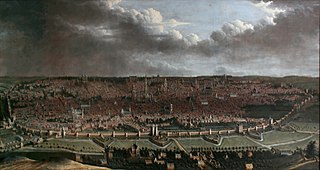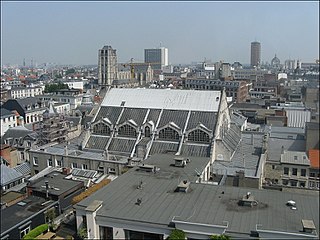
Beveren is a municipality in the Belgian province of East Flanders which comprises the towns of Beveren, Doel, Haasdonk, Kallo, Kieldrecht, Melsele, Verrebroek and Vrasene.

Philip Fruytiers (1610–1666) was a Flemish Baroque painter and engraver. Until the 1960s, he was especially known for his miniature portraits in watercolor and gouache. Since then, several large canvases signed with the monogram PHF have been ascribed to him. These new findings have led to a renewed appreciation for his contribution to the Antwerp Baroque.
The Ruckers family were harpsichord and virginal makers from the Southern Netherlands based in Antwerp in the 16th and 17th century. Their influence stretched well into the 18th century, and to the harpsichord revival of the 20th.
Flemish literature is literature from Flanders, historically a region comprising parts of present-day Belgium, France and the Netherlands. Until the early 19th century, this literature was regarded as an integral part of Dutch literature. After Belgium became independent from the Netherlands in 1830, the term Flemish literature acquired a narrower meaning and refers to the Dutch-language literature produced in Belgium. It remains a part of Dutch-language literature.

The Royal Museum of Fine Arts Antwerp is a museum in Antwerp, Belgium, founded in 1810, that houses a collection of paintings, sculptures and drawings from the fourteenth to the twentieth centuries. This collection is representative of the artistic production and the taste of art enthusiasts in Antwerp, Belgium and the Northern and Southern Netherlands since the 15th century.
Preservation of meaning in library, archival or museum collections involves understanding spiritual, ritual, or cultural perceptions of value for specific objects, and ensuring these values are maintained and respected. Meaning is something assigned to objects of cultural or spiritual significance based on interpretations and perceived values by user populations, a process known as social construction of an object. When moved to memory institutions such as libraries or museums, these objects of social construction require unique approaches to preservation and maintenance in order to remain relevant as representations of cultural or spiritual societies.

Jos Van Immerseel is a Belgian harpsichordist, pianist and conductor.
This is a timeline of artists, albums, and events in progressive rock and its subgenres. This article contains the timeline for the period 1960–1969.

Colijn de Coter was an early Netherlandish painter who produced mainly altarpieces. He worked primarily in Brussels and Antwerp. His name was sometimes given as Colijn van Brusele, indicating that he hailed from Brussels or at least that he lived there most of his active life. He also signed several paintings with Coliin de Coter pinxit me in Brabancia Bruselle.

Gaspar or Casper van Eyck was a Flemish painter of marine subjects and sea-fights. He worked in Antwerp and spent some time working in Genoa and Madrid.

Theodoor van Heil, was a Flemish landscape painter known for his winter landscapes, city views and scenes of burning cities.

Nicolaas van Eyck or Nicolaes van Eyck (1617–1679) was a Flemish painter active in Antwerp in the middle of the 17th century. He is known for his equestrian and battle scenes, landscapes and portraits. He also painted a few civil processions, including parades of the Antwerp civil militia.
The following is a timeline of the history of the municipality of Antwerp, Belgium.

Antwerp was developed as a fortified city, but very little remains of the 10th century enceinte. Only some remains of the first city wall can be seen near the Vleeshuis museum at the corner of Bloedberg and Burchtgracht, and a replica of a burg (castle) named Steen has been partly rebuilt near the Scheldt-quais during the 19th century. Parts of the canals that protected the city between the 12th and 16th century have been covered and used as a sewage system. Both the 16th century city walls and the 19th century fortifications have been covered up by major infrastructure works during the 19th and 20th century.

Jan Baptist Bonnecroy or Jean Baptiste Bonnecroy was a Flemish painter and engraver known for his large panoramic city views and marine paintings.

The Palace of the Count of Flanders is a neoclassical palace in Brussels, Belgium. It was originally built between 1776 and 1781 for Countess Brigitte of Tirimont-Templeuve, though it was heavily expanded in the 19th century. Nowadays, it houses the Court of Audit of Belgium.
Hans Nieuwdorp is a Belgian art historian specialized in late medieval sculpture. In 2000, he was appointed director of the Art Museums of the City of Antwerp.
The Organ collection Ghysels is a museum collection of mechanical dance and fairground organs. Since 2010 it is exhibited at the Kijk- en Luisterdepot in Kallo in Beveren, Belgium. It was brought together by Jef Ghysels from Schaerbeek. Great part of the organs operated before the First World War.

The bourse at Antwerp is a building in Antwerp, Belgium, which was first opened in 1531 as the world's first purpose-built commodity exchange. The Royal Exchange in London was modelled on the Antwerp bourse. The bourse has been described as "the mother of all stock exchanges".


















